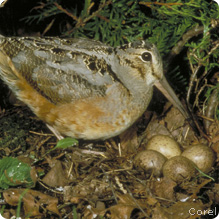
The woodcock is one wild bird to watch. Here are some woodcock-watching tips.
What You Do
- Where to Go
Woodcocks live in the eastern half of the United States. But not just anywhere there: They need young forests—brushy places where lots of shrubs and trees are growing but are still small. - What Time of Year to See Them
Woodcocks blend in so well that, most of the time, you probably won’t notice them. Your best bet is to go when they’re noisily courting in the spring. That starts around February way down south and about the middle of May way up north. If you live somewhere in between, then the season will start somewhere in between, too. (Ask someone at a nearby nature center or wild-bird supply store to find out more.) - What Time of Day
Put on a warm jacket and boots as the sun goes down and head to the nearest woodcock singing ground. That would be an open area next to the birds’ young forest home. It might be a field, forest clearing, cemetery, or old logging road. The show starts about 15 minutes or so after sunset. - What to Listen For
First, listen for a buzzy “Peent!” That’s the male’s call. He’ll repeat this several times and then burst into the air. - What to Watch For
Watch for him spiraling upward, silhouetted against the darkening sky. If you’re close enough, you might be able to hear his wings twittering. As he circles high overhead, he chirps and then starts to drop back to Earth. Finally, he glides quietly in a back-and-forth pattern, ending about where he started from. - What Else to Notice
After he’s back on the ground, he starts peenting again. He repeats his performance in hopes that a female will choose him as a mate. Other males may join in the act, too. This “celebration” might last as long as the moon is shining. (Note: To get closer to a woodcock without disturbing him, move only while he’s in the sky and keep still when he’s on the ground.) - Can’t Find Woodcocks?
- If you’re in the right region, but can’t find any woodcocks, it could be because there aren’t any more young forests around.
- Young forests grow up in unused fields or in cleared patches of old forest.
- Trouble is, there are fewer and fewer such places. Too much open land is changing into development for people instead of growing into new forests for wildlife.
Thanks to Andrew Weik for his woodcock-spotting tips. He studies woodcocks and other creatures for the U.S. Fish and Wildlife Service at Moosehorn National Wildlife Refuge in Baring, Maine.

